Although this topic has been beaten to death, it is still not clear to me whether Adaptive Binary Trees (ABTs) are k-d trees or AABB tress.
From my (limited) knowledge attained from these forums, I'd say ABTs are really AABB trees constructed with an algorithm similar to k-d construction algorithms. However, some people (including Yann) seem to disagree, which makes me wonder if I'm misunderstanding the original idea. I would like a clarification purely for better understanding this structure (and not to prove anyone wrong).
As I understand (and as it was previously mentioned on another post):
- each k-d tree node stores a dividing plane
- each AABB tree node stores an AABB box
- each ABT tree node stores an AABB box
With this in mind, with dynamic elements the ABT tree is ALWAYS an AABB tree even if it majorly diverges from the (k-d tree-like) way it was initially constructed.
To illustrate what I mean, here is an example construction of an ABT tree.
Here are the original objects:
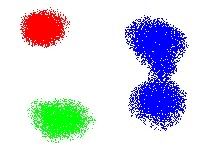
During the first step, construct tree in a k-d like way by recursively finding splitting planes (for the sake of simplicity, I am not allowing for overlaps):
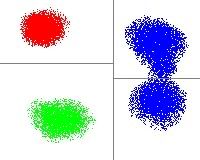
During the second step, create AABB's for each node:
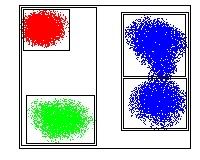
At this point, the ABT definitely looks like an AABB tree.
Now consider the case where the green object moves (with simple adjustments between the leaf and root without rebuilding the tree):
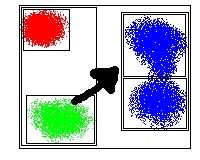
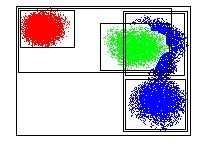
As is shown, the tree remains AABB but does not retain much of its original k-d tree properties.
Please let me know if I am misunderstanding something or if my reasoning makes sense.
PS: Please keep this thread free of condescending, pretentious, or flaming comments.
 During the first step, construct tree in a k-d like way by recursively finding splitting planes (for the sake of simplicity, I am not allowing for overlaps):
During the first step, construct tree in a k-d like way by recursively finding splitting planes (for the sake of simplicity, I am not allowing for overlaps):
 During the second step, create AABB's for each node:
During the second step, create AABB's for each node:
 At this point, the ABT definitely looks like an AABB tree.
Now consider the case where the green object moves (with simple adjustments between the leaf and root without rebuilding the tree):
At this point, the ABT definitely looks like an AABB tree.
Now consider the case where the green object moves (with simple adjustments between the leaf and root without rebuilding the tree):

 As is shown, the tree remains AABB but does not retain much of its original k-d tree properties.
Please let me know if I am misunderstanding something or if my reasoning makes sense.
PS: Please keep this thread free of condescending, pretentious, or flaming comments.
As is shown, the tree remains AABB but does not retain much of its original k-d tree properties.
Please let me know if I am misunderstanding something or if my reasoning makes sense.
PS: Please keep this thread free of condescending, pretentious, or flaming comments.


